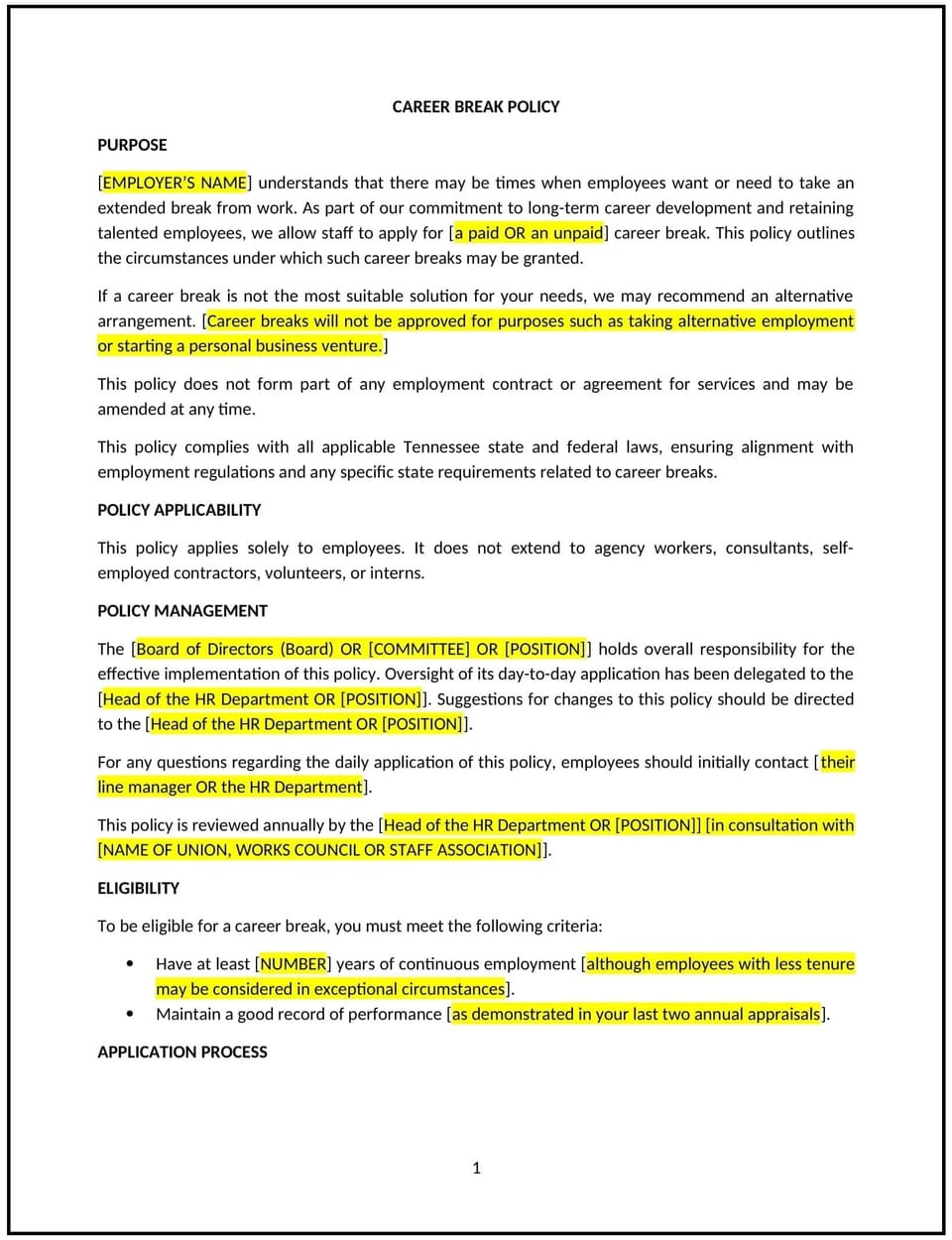Career break policy (Tennessee): Free template

Career break policy (Tennessee)
This career break policy is designed to help Tennessee businesses create guidelines for employees taking extended time off for personal or professional development. It outlines procedures for requesting leave, job protection, and returning to work.
By adopting this policy, businesses can support employee growth, enhance retention, and promote a positive workplace culture.
How to use this career break policy (Tennessee)
- Define eligibility: Clarify which employees are eligible for career breaks, such as those with a minimum tenure or performance level.
- Set leave duration: Specify the maximum length of a career break, such as six months or one year.
- Establish request procedures: Provide steps for employees to request a career break, including notice requirements and documentation.
- Address job protection: Guarantee that employees will return to the same or an equivalent position after the break.
- Train managers: Educate supervisors on handling career break requests and maintaining workflow during employee absences.
- Review and update: Assess the policy annually to ensure it aligns with evolving business needs and employee expectations.
Benefits of using this career break policy (Tennessee)
This policy offers several advantages for Tennessee businesses:
- Supports employee growth: Encourages employees to pursue personal or professional development opportunities.
- Enhances retention: Reduces turnover by providing employees with flexibility and support.
- Promotes workplace culture: Demonstrates a commitment to employee well-being and work-life balance.
- Attracts talent: Makes the business more appealing to candidates seeking flexible work options.
- Aligns with modern trends: Keeps businesses competitive by embracing innovative leave policies.
Tips for using this career break policy (Tennessee)
- Communicate the policy: Share the policy with employees and include it in the employee handbook.
- Provide training: Educate managers on handling career break requests and maintaining workflow during employee absences.
- Monitor compliance: Regularly review career break requests to ensure adherence to the policy.
- Address issues promptly: Take corrective action if career break requests are mishandled or denied improperly.
- Update regularly: Assess the policy annually to ensure it aligns with evolving business needs and employee expectations.
Q: How does this policy benefit businesses?
A: By offering career breaks, businesses can support employee growth, enhance retention, and promote a positive workplace culture.
Q: Are career breaks paid or unpaid?
A: This depends on the business’s policies. Most career breaks are unpaid, but some businesses may offer partial pay or benefits.
Q: What should businesses do if an employee does not return after a career break?
A: Businesses should have procedures in place to address this, such as requiring a commitment to return or offering alternative arrangements.
Q: How can businesses minimize disruptions during employee absences?
A: Businesses can cross-train employees, use temporary staff, or adjust workloads to maintain productivity during absences.
Q: How often should businesses review this policy?
A: Businesses should review the policy annually or as needed to ensure it aligns with evolving business needs and employee expectations.
This article contains general legal information and does not contain legal advice. Cobrief is not a law firm or a substitute for an attorney or law firm. The law is complex and changes often. For legal advice, please ask a lawyer.


